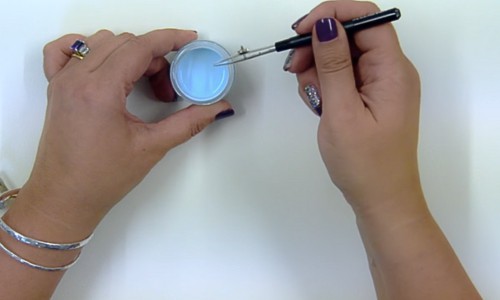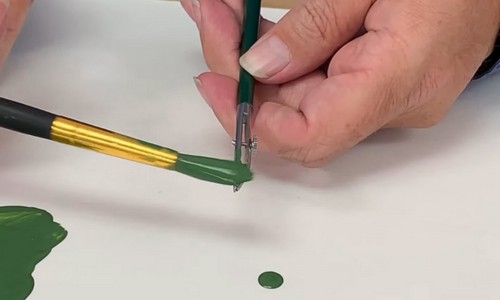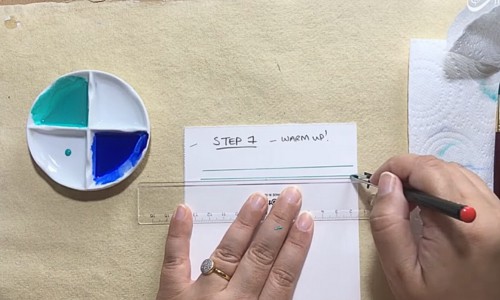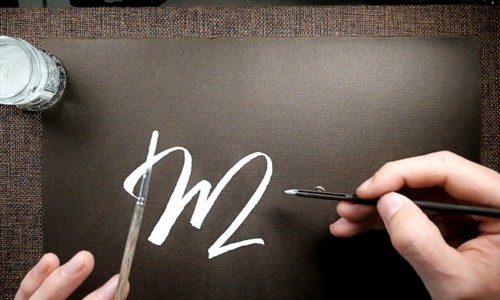Have you ever encountered a pen with a knurled adjustment nut and two metal jaws in a compass set?
Some would just set this tool aside without knowing what they’re missing. That metal accessory is a ruling pen, and it’s included in those compass sets for a reason.
In this article, we’ll learn how to use a ruling pen. Come and join me, and let’s uncover a multitude of techniques and different ways you can use this tool as an aspiring artist or a professional.
Table of Contents
Ways o Fill Ruling Pens
1. Filling by dipping.
- Prepare an ink well and open the lid.
- Pick up the ink by dipping the pen into the ink bottle. The tip should be submerged into the ink about half an inch.
- You can scrape the sides of the tips into the bottle’s mouth to remove any excess liquid.
2. Using a small brush.
- Hold the ruling pen with one hand and position it sideways.
- Use your other hand to dip a small brush into the ink.
- Gently slide the brush into the gap between the pen tips to deposit the ink.
3. Fill the ink with a dropper.
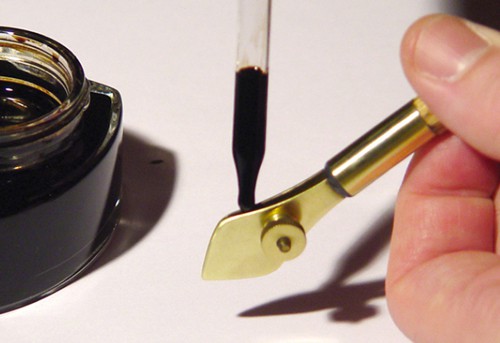
- Load the dropper with ink like usual.
- Take the ruling pen and keep it on its sides or a bit slanted.
- Slowly fill the tip’s gap with a few drops of ink.
Reminders
- Wipe away excess ink to avoid unwanted stains.
- Make sure the coloring fluid is viscous enough or not too runny to avoid dripping.
Ruling Pen Applications
1. Creating Crisp Lines With Ruling Pens
Long before technical pens were invented, ruling pens were widely used for engineering-related drawings and maps. It is used as a lining pen for miniature projects as well.
Once you get familiar with this tool, you can start using it to ink your projects. First, let’s practice making lines. Follow the steps below to create clean lines with varying line thicknesses.
- Prepare suitable paper, like cold press watercolor types, and a ruler. Avoid using thin paper as it might tear with the sharp edges of the ruling pen. Use a beveled ruler or one with a cork/rubber backing, as it will stay in place better while you draw.
- Fill the ruling pen with ink.
- Hold the pen at the grip section. You can use a tripod grip.
- Position the ruler on the paper where you want your lines to be.
- Rest the ruling pen tips against one side of the ruler. The tips should touch the paper. No need to apply much pressure, just drag the nibs smoothly along the guide.
- Refill ink and adjust the screw knob as needed. Screw it tighter if you wish to create thinner lines, or loosen it if you want to make bolder strokes.
2. Working With Other Tools
Maximize the capabilities of your ruling pen by using other tools such as a compass, french curves, and protractors.
French curves and protractors can be used in the same way as the ruler. Check out the steps to use a ruling pen together with a compass.
- A standard compass typically comes with provisions for pencils, while others have ruling pen attachments. Install and fix the ruling pen on the provision or screw it to the compass as an attachment.
- Fill the ruling pen with ink.
- Determine where you want the center of your circle to be, then place the compass needle there.
- Spread the arms of the compass according to the diameter of the circle you want to create.
- Bring the ruling pen tips down. Again, make sure both tips touch the paper.
- While keeping the needle steady at the center, rotate the compass until you’ve drawn a circle.
3. Masking Fluid Applicator
An art ruling pen offers a lot of potential. It can work with masking fluid and can hold up with acrylic paint, gouache, and watercolor as well.
Masking fluid is a useful tool used on canvas and paper to protect details from getting inked or wet.
A ruling pen can create fine lines as thin as 0.5mm, something that you would want for masking the finest details.
- Conceptualize and carefully plan the placement of the masking fluid.
- Finalize and sketch your plan.
- Check the masking fluid consistency. If it’s too dry, take a dropper, add a few drops of water, and mix.
- Load the ruling pen with masking fluid.
- Wipe away the excess fluid.
- Adjust the ruling pen to its finest setting or whatever line width you wish to achieve.
- Carefully trace the pencil lines of your drawing, then let them dry completely.
- If you made a mistake, scrape the line off before you proceed.
- Once everything’s dry, start painting the background.
4. Calligraphy
Ruling pen calligraphy started with the German calligrapher, Gottfried Pott. He changed the design of standard ruling pens, creating a version with pointed heads and wide edges, which had an increased ink width range and allowed writers to adjust their writing angle more easily.
Modern calligraphy pens can act as a chisel, brush, or flat edge pen, depending on how you hold them.
- Prepare your paper. Go for a thicker paper that is a bit rough or toothed.
- Place some layers of paper underneath for added support and flexibility.
- Fill the ruling pen with your choice of ink.
- Make thin lines with the pointed tip and thicker line widths by using the curved side or by changing angles.
- If you are still not comfortable with freehand calligraphy, draft your letters using a pencil and trace your way with your ruling pen.
- Depending on the style you want to create, you can meticulously go fast or slow. Swift strokes can splatter the ink, which adds to its uniqueness.
- Feel free to explore and experiment.
Understanding the Ruling Pen
1. What is a Ruling Pen?
A ruling pen is a classic precision instrument made up of two tapered metal tips designed to apply ink or drawing fluid to technical drawings and maps.
It comes in different shapes and sizes and has a handle and a screw knob that you can manipulate to adjust the opening in between the tips.
Together with a ruler, french curve, compass, and other instruments, a ruling pen can create precise lines and curves of varying widths.
2. How Does a Ruling Pen Work?
A ruling pen is usually partnered with bottled ink and other mediums like masking fluids, paint, and other liquid coloring materials adjusted to a certain consistency.
The narrow gap between the tips serves as its ink reservoir. As mentioned, you can load the ink in by dipping, using a brush, or a dropper.
To adjust the line width, turn the knob and screw in to produce finer lines. Likewise, loosen the screw knob to create thicker lines.
Conclusion
If you’re an artist who works with liquid mediums, it’s high time to learn how to use a ruling pen and try this wonderful inking tool.
Aside from using it for technical applications, ruling pens are good for enhancing different coloring mediums and viscous materials like masking fluids.
If you’re a calligrapher, having them would help you explore different styles and artistic possibilities with ink.
Who would not agree that this intricate tool deserves to thrive in this modern world? On word, they are old but gold!

Art has always been a part of my life; it influences my upbringing and later my career choice. For me, it is always a part of my parenting technique. So for whichever purpose that you come to art, you can start here with us.

